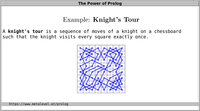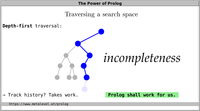Facets of Prolog
| Video: |  |
Prolog is ...
Prolog is a very simple language
All data are represented by Prolog terms.
There is a single language element, called a clause. A clause is of the form:
Head :- Body.
This means that if Body holds, then Head holds. The infix operator (:-)/2 represents an arrow from right to left: ←.
If Head always holds, then :- Body can be omitted.
The above is enough to write useful first Prolog programs.
You may not believe this, so witness the evidence: All programs presented in the following consist only of such clauses.
In fact, all known computations can be described in terms of such clauses, making Prolog a Turing complete programming language. One way to implement a Turing machine in Prolog is to describe the relation between different states of the machine with clauses of the form "If the current state is S0 and the symbol under the tape head is T, and ... then the next state is S". See turing.pl for one implementation, and Thinking in States for more information.
Prolog is a declarative language
This declarative nature often allows for very concise, clear and general specifications. It is unlikely that shorter formalisms that are equally clear and expressive exist.
For example, let us describe the relation between a list and its length, using integer arithmetic:
Note: In some Prolog systems, you currently need to include a dedicated library to use declarative integer arithmetic.
More...list_length([], 0).
list_length([_|Ls], N) :-
N #> 0,
N #= N0 + 1,
list_length(Ls, N0).
We can read this declaratively as follows:
- The length of the empty list [] is 0.
- If the length of the list Ls is N0 and N is N0+1, then the length of [_|Ls] is N. Further, this only holds if N is greater than 0.
?- list_length([a,b,c], L).
L = 3.
However, this imperative reading does not do justice to what we have actually implemented, because the definition also covers several additional usage patterns. For example, given a specific length, we can ask whether there are lists of that length:
?- list_length(Ls, 3).
Ls = [_A,_B,_C]
; false.
Using the most general query, we can even ask for all answers that Prolog finds in general:
?- list_length(Ls, L).
Ls = [], L = 0
; Ls = [_A], L = 1
; Ls = [_A,_B], L = 2
; Ls = [_A,_B,_C], L = 3
; ... .
We say that the relation is usable in different modes. Characteristically, Prolog reports all answers via backtracking.The predicate length/2 is part of the Prologue for Prolog draft, and already available as a built-in predicate in almost all Prolog implementations with the above semantics.
Prolog is a logic programming language
Prolog is firmly rooted in logic.
A pure Prolog program consists of a set of Horn clauses. Its execution can be regarded as a special case of resolution.
This connection to formal logic allows us to apply powerful declarative debugging techniques that are based on logical properties of the program. For example, adding a constraint can at most reduce the set of solutions, and adding a clause can at most extend it. This property of pure Prolog programs is called monotonicity.
See the GUPU system by Ulrich Neumerkel for an impressive application of these ideas.
Prolog is a homoiconic language
homoiconic: from ὁμός = "same" and εικών = "image"
Prolog programs are also valid Prolog terms! This has many great advantages: It is easy to write Prolog programs that analyze, transform and interpret other Prolog programs. You can use the built-in predicate read/1 to read a Prolog term, and thus also a Prolog clause.
There is a powerful mechanism to rewrite Prolog programs at compilation time, so that you can easily implement domain-specific languages that help you solve your tasks more naturally.
You may not believe this, because some goals—such as list_length(Ls, N)—look like Prolog terms as defined above, whereas other goals—such as N #> 0—look quite different. The reason for this is that Prolog provides prefix, infix and postfix operators that let you write Prolog terms in a more readable way. For example, the Prolog term +(a,b) can also be written using operator notation as a+b. The abstract syntax remains completely uniform, and you can read and process all Prolog terms independent of how they are written down.
You can dynamically define custom operators for specific use cases.
Prolog is a very dynamic language
The dynamic nature of Prolog also makes the language ideally suited for writing programs that are extensible by custom rules that other programmers and even regular users provide. Proloxy and Gerrit Code Review are examples of this approach: You configure these programs by supplying Prolog rules that express your requirements in a very readable and flexible way.
See A Couple of Meta-interpreters in Prolog for more information.
You can define an interpreter for pure Prolog in two lines of Prolog code.
Prolog is a very versatile language
Prolog's versatility and power are rooted in implicit mechanisms that include search, unification, argument indexing and constraint propagation. You can use these mechanisms to your advantage, and delegate many tasks to the Prolog engine.
| Video: |  |
This page was sent to you by a Prolog HTTPS server.
More about Prolog
Main page
from Hacker News https://ift.tt/eVuApnL
No comments:
Post a Comment
Note: Only a member of this blog may post a comment.